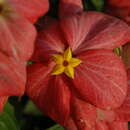en
names in breadcrumbs


Mussaenda philippica (Aklan: Agboy) is a plant species in the family Rubiaceae that grows as a shrub or small tree. Native to the Philippines it is commonly grown elsewhere as an ornamental species.[1][2] Known varieties include: "Doña Luz" (pink), "Doña Alicia" (dark pink), "Queen Sirikit" (light pink), "Doña Aurora" (white), and "Doña Eva" (dark red).
Mussaenda 'Doña Aurora'. ‘Doña Aurora’ has calyx lobes all petaloid, creamy to greenish-white above; prominent greenish-white veins below. After anthesis, lobes become more greenish-tinged, slightly curved and limp. It is named after the wife of former President Manuel L. Quezon. It was first found in 1915 in the vicinity of Mt. Makiling as a spontaneous mutant of the species Mussaenda philippica. It has been utilized as one of the parents in the development of the mussaenda hybrids.
Mussaenda philippica (Aklan: Agboy) is a plant species in the family Rubiaceae that grows as a shrub or small tree. Native to the Philippines it is commonly grown elsewhere as an ornamental species. Known varieties include: "Doña Luz" (pink), "Doña Alicia" (dark pink), "Queen Sirikit" (light pink), "Doña Aurora" (white), and "Doña Eva" (dark red).
Mussaenda 'Doña Aurora'. ‘Doña Aurora’ has calyx lobes all petaloid, creamy to greenish-white above; prominent greenish-white veins below. After anthesis, lobes become more greenish-tinged, slightly curved and limp. It is named after the wife of former President Manuel L. Quezon. It was first found in 1915 in the vicinity of Mt. Makiling as a spontaneous mutant of the species Mussaenda philippica. It has been utilized as one of the parents in the development of the mussaenda hybrids.